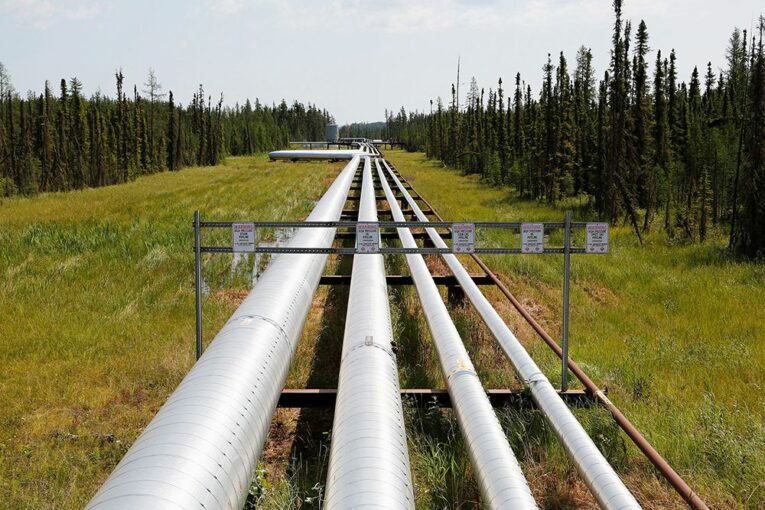
A frustrating period for some Alberta natural gas producers has come to an end with a blast of cold weather — pushing up prices and shrinking the discount to U.S. markets — while promising signs for the sector are emerging with billion-dollar infrastructure investments.
Calgary-based Enbridge announced last week it intends to invest an estimated $3.6 billion to expand capacity on the T-South segment of its B.C. gas pipeline network by 300 million cubic feet per day.
It will also hold an open season to determine interest in a proposed $1.9-billion expansion of its T-North segment in the province.
“There’s not much doubt that global gas demand will grow given its abundance, security benefits and lower emissions. We see gas continuing to be a critical part of the energy supply mix well into the future,” Enbridge CEO AL Monaco told analysts Friday.
News of increased pipeline capacity is welcomed by petroleum producers, while they await completion of the LNG Canada project off the West Coast by the middle of the decade, allowing Western Canada to become more connected to global markets.
It also arrives after a turbulent period earlier this year when spot prices for benchmark AECO natural gas in Alberta were hobbled — at times — between August and late October by a confluence of challenges, leading to a hefty discount relative to U.S. markets.
Some producers even temporarily shut in output because of the steep price differential.
“AECO has definitely recovered, beginning this month,” said industry analyst Ian Archer, an associate director with S&P Global Commodity Insights.
Natural gas prices south of the border have been strong this year, driven by rising demand, record LNG exports and the deepening energy crisis in Europe.
According to a report Tuesday by the U.S. Energy Information Administration, spot prices at Henry Hub in Louisiana are expected to average US$6.49 per million British thermal units (mmBTU) this year, up about two-thirds from 2021.
In Canada, markets throughout the first half of the year were also buoyant and output climbed as producers drilled more wells.
Western Canadian gas output has averaged about 17.5 billion cubic feet per day (bcf) this year, up by more than one bcf a day from a year ago.
However, maintenance work on the Nova Gas Transmission Line (NGTL) system in Alberta this summer and slower completion of some infrastructure developments in Western Canada led to less-than-expected capacity to move gas out of the region, Archer noted.
The price differential between AECO and the U.S. Henry Hub in Louisiana topped US$6 per thousand cubic feet (mcf) in late August.
“AECO really only started to improve at the beginning of November, and that’s driven by a couple of things . . . a lot of this maintenance is now complete, and it got very cold and that has increased demand in Alberta,” Archer said.

The disconnect was so deep that in September, companies such as Kelt Exploration and Tourmaline Oil announced they had temporarily cut some gas production after spot prices tumbled at AECO and in B.C.
“At that point, operationally if you can, you are better off shutting-in gas and knowing that this is just temporary,” Kelt’s chief financial officer Sadiq Lalani said in an interview.
“Once it’s sold, it’s gone.”
However, as planned maintenance work has wrapped up and cold weather has set in on Western Canada since the start of November, the situation has shifted.
Archer noted the price differential averaged more than US$3.30 per mcf in October, but as of Monday, it has dropped to 91 cents through the first week of November.
“We actually have seen a pretty huge improvement in AECO,” Lalani agreed. “We’ve seen it kind of come out of slump here in the last week.”
Recommended from Editorial
-

Enbridge green-lights $3.6 billion gas pipeline expansion in B.C.
-

Recent plunge in Canadian natural gas price shuts in some production, but relief is on the way
-

Varcoe: As global natural gas prices soar, Alberta producers face ‘astronomical’ discount
-

Move over oil — natural gas is the hottest commodity in the world now
Analyst Jeremy McCrea with Raymond James noted western Canadian gas storage levels were sitting at only 75 per cent full heading into the winter, its lowest point in more than a decade.
“It’s an early start to the cold weather . . . with storage at these lows,” he said Tuesday. “That’s why we’re seeing the (price) differential come in rather quickly.”
Many producers are expecting healthy Alberta gas prices through the winter — a period when consumption picks up — and heading into 2023.
However, Advantage Energy CEO Michael Belenkie noted Western Canada gas prices will always be dominated by limits to pipeline capacity, and price weakness at AECO could return next summer.
“In the coming two years, we expect to see prices shrinking in the summer times, in particular, with limited export from Alberta as supply grows to fill what pipes are available,” he said.
“After that is when LNG Canada comes on and . . . that will create a short or mid-term period of time where the markets will be, once again, more stable.”
Archer expects prices for Alberta natural gas to moderate a bit next year, but the market should still be in healthy shape.
He projects AECO prices will average about US$3.90 per mcf next year, as Canadian consumption keeps growing, more coal-fired power generation is converted to natural gas and demand from the oilsands increases.
“Overall, the short to medium term for Canada is pretty good,” Archer added. “And then we have the pickup of LNG Canada in 2025 and a connection to global markets.”
Chris Varcoe is a Calgary Herald columnist.
You can read more of the news on source
